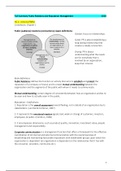Full Summary Public Relations and Reputation Management 2020
HC 1 - Intro to PRRM
Cornelissen, Chapter 1
Public (audience) relations (connections) classic definitions:
Gordon: focus on relationships.
Cutlip: PR is about establishing a
long lasting relationship that
creates a steady connection.
Grunig: PR is about
understanding what the needs
are for everybody that is
involved by an organization,
keep their interest.
Book definitions
Public Relations: defines the function or activity that aims to establish and protect the
reputation of a company or brand, and to create mutual understanding between the
organization and the segments of the public with whom it needs to communicate.
Mutual understanding: certain degree of consistently between how an organization wishes to
be seen and how its actually seen in the public.
Reputation: 3 definitions:
1. Reputation is the overall assessment (overall feeling, not in detail) of an organization by its
stakeholders. (van Riel & Fombrun, 2007)
2. It represents the emotional reaction (good, bad, weak or strong) of customers, investors,
employees, & public. (Fombrun, 1996)
3. It encompasses dimensions, such as product quality, innovation, investment value, people
management and responsibility.
Corporate communication is a management function that offers a framework for the effective
coordination of all internal and external communication with the overall purpose of
establishing and maintaining favourable reputations with stakeholder groups upon which the
organization is dependent (an organization is dependent on the relationship that it has with
the consumer, providers, community etc.).
1
,Why is it relevant?
PR doesn’t only take place
between an organization and
their public.
Number of other ways that PR
are important.
Little history of PR
Public Relations have always existed somewhat informally: they have a role in capturing the
attention of the public and mobilizing citizens. It is not a surprise that some of the oldest PR
material we have today is connected to political propaganda, or recruitment for wars.
In the early 1900s, with the Industrial Revolution, and the development of advertisement as a
structured concept, Public Relations became more formalized.
In 1900 the Publicity Bureau is founded in Boston. Meanwhile, similar institutions begin to
appear in the UK.
Edward Bernays
- Considered to be the founding father of Public Relations as a discipline
- Was the nephew of Freud and deeply influenced by his theories about the
subconscious
- Introduced the concept of the focus group and worked with tobacco brands and other
controversial products
Gustave LeBon
“The masses have never thirsted after truth. They turn aside from evidence that is not to their
taste, preferring to deify error, if error seduce them. Whoever can supply them with illusions
is easily their master; whoever attempts to destroy their illusions is always their victim.”
Public Relations in the 1980’s
Restructuring trend: all activities within an organization evaluated on the basis of what they
contribute to the organization.
Communication professionals are consolidated in PR departments and procedures (e.g.
Communication guidelines) are established for the whole organization.
+ Public Relations start being recognized as a function the whole organization benefits from
- No consideration is given for the role of stakeholders
2
,Public Relations in the 1990’s
Strategic Positioning: organizations use PR as a way to achieve a competitive corporate
identity.
Communication professionals have the role to shape an organization’s brand, which can be
conveniently “positioned” within the minds of stakeholders.
+ Public Relations become a crucial strategic tool for organizations to be more profitable
- Stakeholders are considered passively, as receivers of messages that can easily be controlled
and managed.
Public Relations in the 2000’s
Stakeholder Engagement: thanks to new media, stakeholders become real participants in an
organization’s public relations.
Old principles of strategic communication still apply, but the relationship with stakeholders
becomes a dialogue rather than a one-directional communication.
+ Stakeholders can be ”activated” and become advocates for the organization.
- Organizations will be held to substantially higher standards of transparency and genuine
behaviour.
PR nowadays
- PR is more complex, technical and precise
- Divided into different areas, require different talents and
specializations
- Driven by technological changes (new media)
H1: Defining Corporate Communication
All organizations, of all sizes and operating in different sectors and societies, must find ways
to successfully establish and nurture relationships with the stakeholders on which they are
economically and socially dependent. The management function that has emerged to deal
with this task is corporate communication, and this chapter has made a start by outlining its
importance and key characteristics: communication, identity, image, reputation, mission and
vision.
HC 2 – Stakeholder communication
Cornelissen, Chapter 4 and 13
An organization doesn’t operate on its own, but is emerged in a community of people.
H4: Stakeholder Management and Communication
Main purposes of corporate communication: the management of relationships with
stakeholders (both in theory and practice)
3
, Adoption of the stakeholder perspective moves away from a neo-classical economic theory to
a socio-economic theory.
Stakeholder: is any group or individual who can affect or is affected by the achievement of
the organization’s purpose and objectives.
Stake: an interest in something.
Neo-classical economic: purpose or organization is to make profit by doing so that business
contribute to wealth for itself as well as society at large (maximise profits).
The Input-output model (share-holder model)
Shareholder: anyone who owns a share of the organization (VB stock or supplies)
- Macht licht bij de organisatie
- Partijen zijn afhankelijk van de organisatie (financiele belangen)
4 elements behind Input-Output Model:
Socio-economic theory: suggests that the question of ‘who counts’ extends to other groups
besides shareholders who are considered to be important of the organization and the welfare
of society (mediate between interests)
The Stakeholder model
4 elements behind Stakeholder Model:
4






